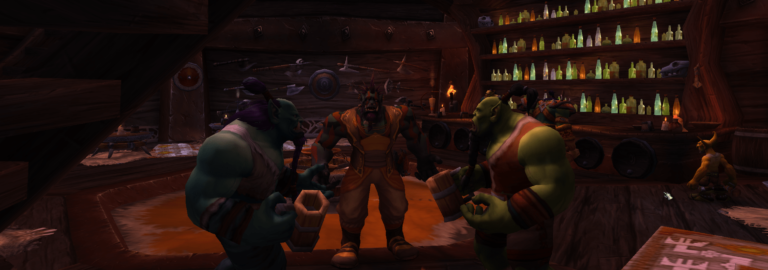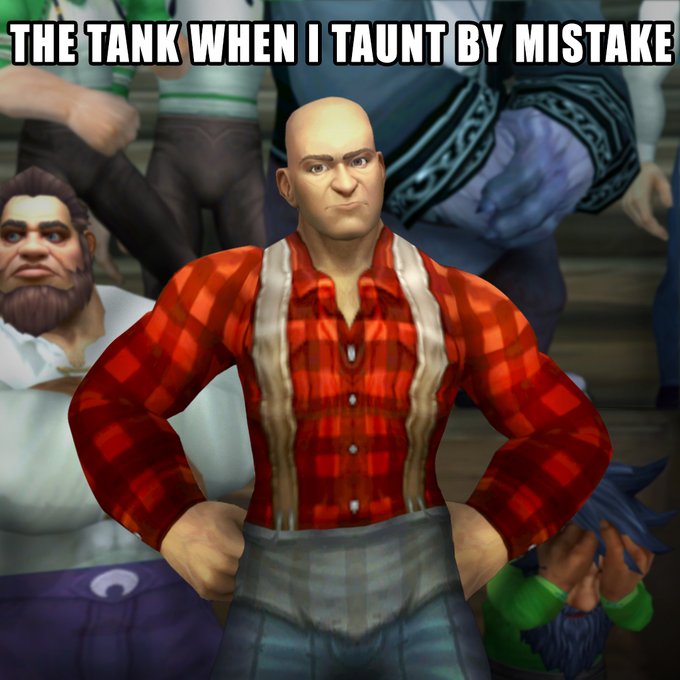Welcome to Casual Friday’s Intermediate Mythic+ Guide. For this guide, we assume you have already read through and executed our Intro to Mythic+ guide, or have progressed enough on your own that you feel ready to introduce Mythic+ affixes and more advanced dungeoning topics.
For this guide, you will need:
- A maximum level character that has completed all available Mythic+ dungeons at least one time
- A handful of gear, perhaps 10-20 item levels higher than you started your Mythic+ journey
- A reserve of gold to purchase or craft consumables
- Glorious purpose
- Gotten comfortable with the Mythic+ timer despite its ability to impart emotions you only thought existed in dreams
Builds, Gear, and Simming
If you followed our guide recommendations and ventured to the class Discords, then you are already one step ahead. At this point, you should be approaching total world domination your 4-piece set bonus, making the latest class Discord guides ever more relevant since they will recommend several talents that synergize with the set bonuses. If you haven’t joined your relevant class Discord, you can find the full list on our resources page.
Another place you can see some decent builds is at Subcreation. This website parses data from the best runs posted to Warcraft Logs and displays it in a digestible format. Your performance may vary because these are the best of the best, aggressively pulling dungeons that might dictate some modifications to builds you find on guide websites and class Discords. But that’s part of the adventure in WoW: the ability to escape reality for only $15/month experimentation and preference might lead you down a different path when choosing a build.
You should also be collecting the time-gated crafting materials required to craft your first few high-end items. These items can supplement gear you haven’t already replaced, or provide a best-in-slot boost via enhanced extra effects for an item. Subcreation.net should provide a section that you can refer to see the crafted items other people are using if it’s not clear in the class Discords.
When in doubt whether an item is an upgrade, or if the “juice is worth the squeeze” for paying to craft something, you can always sim yourself. Simming yourself is a great way to get some cold hard facts on how big of an upgrade an item might be. The first thing you need to do is make sure you have the SimC add-on. For a guide on finding and installing add-ons, head to our resources page. When you have this add-on, type /simc while in-game and copy that entire thread with your vault open. Then, head to Raidbots, a website dedicated to having the latest simulation data at your fingertips. We have a detailed guide on utilizing sims in our resources page.

Consumables
Consumables are an integral part to eking out additional performance from your specialization. As of Dragonflight, the basic consumables are as follows:
- Phial – which used to be known as flasks
- Food
- Weapon Runes/Sharpening Stones/Weight Stones
- Potions
For phials (aka flasks), these are 30+ minute consumables that provide a baseline stat or unique effect that persists through death. As of Dragonflight, you can consume multiple phials and/or be an alchemist to increase the duration of the buff. Knowing which phial is best for you might require some experimentation in-game or via sims, consulting the class Discords, or combing through some logs at warcraftlogs. Since they persist through death, you should never not have a phial buff on you when running Mythic+ content. While their effects may seem small, any little bit you can get to have an edge to conquer your foes is worth exploiting.
Consuming some foods for at least 10 seconds may provide a unique effect or baseline stats to aid you in battle. By default, food buffs expire after 1 hour or on death. Generally, there is a high baseline (intellect, agility, or strength) stat food that will be the best for all classes and specializations. As of Dragonflight, there is an embellishment (that does not count towards your embellishment limits) you can add to your gear that allows them to persist through death and extends the duration. This is mostly a convenience because the breakeven point of the embellishment would require you to consume a ton of food. Food should be consumed at the start of every Mythic+ dungeon. If you die in the dungeon and do not have the persist-through-death embellishment, brief downtime may be found to replace a lost food buff, but do not sweat if you can’t find the time. Sometimes it’s just as good to keep on truckin’ without the buff.
Weapon runes, sharpening stones, and weight stones are secondary stat buffs or unique effects applied directly to your weapon(s). They last 2 hours and persist through death. They should be applied as often as required to not let them expire within the dungeon. You can consult class Discords for the best ones. Be wary, some specializations apply their own unique buffs to their weapons that may not play well with these consumables.
As of Dragonflight, there are two types of potions. One is a combat heal potion that has its own unique 5 minute cooldown with other combat heal potions. You definitely want to carry a stack around while dungeoning and eat them like potato chips when your health is critical. Other potions share their own unique 5 minute cooldown. Most of them aid you in combat, providing a substantial bonus effect that you might want to use on cooldown. Some of them regenerate mana and might be necessary to keep the party moving as quickly as possible. Some of them provide out of combat effects, such as invisibility, that allows you to avoid your daytime responsibilities packs of enemies entirely. Knowing which potions to use at which times might require some dungeon knowledge and consulting your class Discords. Generally, in the 7-14 keystone range, you should be safe to occasionally pop a combat bonus potion as the routes should not include advanced skipping mechanics that require the use of an out of combat potion.
We left Augment Runes off this list intentionally. These are an hour-long baseline stat buff that diminishes on death. They are not crafted, rather they are farmed by doing lower end content. They serve as an additional method of gold-making for people in the lower tiers of endgame content (heroic dungeons, Looking For Raid) as an expense for people at the high tiers of endgame (Mythic raiding and high-end dungeons). They will generally be cost prohibitive to use at all times, so do not worry if you don’t have a stack on you. Or if you do, sell them on the Auction House to raid the coffers of the rich turn a nice profit for yourself!
Cooldown Usage
At this point of playing the game you have come to learn that one of the most fun pieces of gameplay is slamming your cooldowns and going ham. Not all cooldowns are created equal, and that variety definitely keeps Mythic+ interesting. This section addresses not only damage output cooldowns, but healing and tanking cooldowns, too. While we won’t list every single one of them one by one, we definitely think it’s important to address their usage conceptually to help you effectively implement them in Mythic+.
Around our Discord, we have mentioned several times to treat a Mythic+ dungeon like one big 30 minute boss fight. While there is some variance per class and cooldown spell, we generally advise while learning the dungeons to just send your cooldowns as they are available, even multiple times per enemy pack or boss. While running the dungeon, delaying cooldown usage may feel minor, but the missed potential for additional damage by delaying a cooldown 10+ seconds will add up by the end of a dungeon. For example, if you have a 2 minute cooldown, and are able to press it every 2.5 minutes on average, that is 12 usages in a 30 minute dungeon. If you delay it by 10 seconds to where you are pressing it every 2 minutes 40 seconds, that is nearly 1 whole potential cooldown usage missed. For only delaying it 10 seconds per usage! Imagine the math if you only press it every 3 minutes, on average.
A similar approach applies to most tank cooldowns. The best time to utilize a cooldown as a tank is on approach to a pack of enemies so that the initial thwack is tempered. You may also need to save cooldowns for a boss mechanic, affectionately called a tankbuster. Using a cooldown at the start of a pull will give you time to build your resources to sustain yourself while your healer and damage dealers find the best position to start blasting. There is a caveat though. Some tanks have varying degrees of cooldowns, some that you might want to reserve when you know you’re going to take a lot more damage. This is where you need to study your spell texts, experiment in dungeons, and figure out a priority of how you want to utilize your cooldowns. It’s also important to know whether your talents have some sort of cooldown reduction mechanic for using another spell. For example, Brewmaster monks have a mechanic where their brew cooldowns are reduced by their Tiger Palm, effectively making a 6 minute cooldown much shorter. Maximizing effects like this might be necessary to play at the highest level. If your tank spec is blessed with a damage cooldown, then fire that puppy every time it’s up! Sometimes, you might even beat the damage-dealers for that pull!
Playing god with your party’s health is Healer cooldowns are a little trickier, and often require the most dungeon knowledge of all the roles. Some cooldowns are reactionary, where you can press them when your party’s health is at a critical level. Other cooldowns require some prep and should be used in advance of critical moments throughout the dungeon. If you followed our advice in Intro to M+ by running all of the dungeons below level 7, then you will likely start getting a feel for these moments that require preparation. Experimentation as a healer is key, and no two dungeons are going to be the same because they can vary in time, pacing, and your ally’s abilities to dodge damage. That’s perhaps why we are so excited to play our healers in Casual Friday, the variance keeps the role interesting! If you need a community to learn the ropes and experiment with healing, then look no further than Casual Friday!

Interrupts and Knocks
Almost all (poor healing priests) classes or specs have access to an interrupt. Interrupts are used to cancel a casted ability on an enemy to prevent its effect from happening. Nearly every pack of non-boss enemies will have at least one key interrupt. This is where you can utilize a nameplate add-on like Plater with a profile to highlight key interrupts, but it might also be helpful seeing the dungeons and experiencing what can go wrong to learn what you should interrupt.
Another key ability to learn is regularly utilizing knocks. Knocks are a generic term that refers to stuns, incapacitates, displacement spells that move enemies, and hard CC. Sometimes, a group just sends their knocks on cooldown sequentially to keep enemies locked in place, but in some cases there are key abilities that can’t be stopped by interrupt spells that you should really concentrate on to knock to prevent its effect. These enemy abilities come in a variety of versions:
- Big AoE damage that could kill your entire group
- Fixates that cause an enemy to focus on a player other than the tank
- Focused spell channel on a single player, causing a critical amount of damage
An empowerment that entitles an enemy to repeatedly ask for the manager
Most of the time, interrupts and knocks can be used as it seems fit, but as your keystone level rises, coordinating them may be necessary for your success. If you are playing with a community like Casual Friday and utilizing voice communications, you can make it a habit of calling out which target you will focus on interrupting and when you are going to cast your knocks.
To +7, And Beyond! A Primer On Affixes
Starting at keystone level 7, you will begin facing your second affix. You may not have realized it, but you were already facing your first affix at +2, known as Tyrannical and Fortified. These alternate each week, shifting the challenge from bosses to non-bosses, and back, each week. Tyrannical makes each boss more difficult, and Fortified makes non-bosses more difficult. The other affixes (as of Dragonflight Season 2) are listed below, and only affect most non-boss enemies:
|
Level 7 Keystone Affixes that Occur Periodically While in Combat |
||
|
Affix |
What does it do? |
How do I deal with it? |
|
Afflicted |
Afflicted Soul spawn that periodically cast Afflicted Cry, that reduces player’s haste by 100% for 10 seconds. You can remove the Afflicted Soul by using an ability that dispels debuffs, or healing them to 100% health. |
Compose a group that has at least 2 dispels. Classes that cannot dispel are warriors, death knights, rogues, warlocks, and hunters. |
|
Incorporeal |
Incorporeal Beings spawn that continually cast Destabilize, reducing player damage and healing by 50%. You can use any form of interrupt or crowd control to interrupt them. Since they are immune to damage, long-form crowd control is ideal. They disappear when you leave combat |
Compose a group that has at least 2 hard, long duration CCs. Warriors are the only class without a hard, long duration CC. |
|
Volcanic |
Volcanic Plumes appear under players which explode after 2 seconds, dealing 20% of max health in damage and knocking you in the air. |
Run out of the swirly. |
|
Entangling |
Plants appear under you that slows your movement speed by 30%. Moving 10 yards from the plant will remove the penalty, however failing to move within 8 seconds will stun you for 3 seconds. |
Run out of the circle. Abilities that remove movement impairment will immediately clear the circle. |
|
Storming |
Tornadoes appear around players that spin around a circle until disappearing or contacting a player. Colliding with the tornado deals a small amount of damage and knocks and player into the air |
Avoid the tornadoes. |
|
Level 14 Keystone Affixes that Occur On Death or at Specific Health Ranges |
||
|
Affix |
What does it do? |
How do I deal with it? |
|
Spiteful |
When most non-boss enemies die, a Spiteful Shade fixates on a random non-tank player, dealing damage if they come in contact. |
You either have to kill them with your normal attacks towards regular enemies, or their health gradually depletes if ignored |
|
Raging |
When non-boss enemies reach 30% health, they become immune to crowd control. |
Raging can be removed with abilities that remove enrage effects provided by hunters, druids, and evokers, but is not absolutely necessary until the very high end. |
|
Bursting |
When non-boss enemies die, a 4 second damage over time debuff is applied to players, stacking per enemy death. |
Try to stagger enemy deaths or be prepared to keep yourself living if stacks are too high |
|
Bolstering |
On non-boss enemy death, nearby enemies receive a stacking 20% damage buff. |
Tanks be wary. This stacking buff may require you to run away from enemies, otherwise known as kiting. |
|
Sanguine |
On non-boss enemy death, a puddle of Sanguine Ichor appears that heals enemies standing in it and damages players. |
Tanks move enemies out of the puddles, and all players can help using knockback effects. |
Keep Making Friends
One of the biggest hindrances to anyone looking to improve their play, learn on the go, and increase their Mythic+ rating is finding consistent players to play with. While group finder can be an effective way to find groups, there is often the assumption that you already know what’s going on in a dungeon, especially later on in a season. To make friends, you can add them to your friends list by right-clicking their name. Then you can check your friends list by pressing the default button, ‘O.’ Another way to find regular groups in a judgment-free zone is to join a community like Casual Friday. In Casual Friday, it’s easy to find plenty of players ready and willing to help give you the edge in learning, building confidence, and having an all-around great time while playing World of Warcraft. We’re dedicated to being a safe place for everyone to group up and have some fun.





